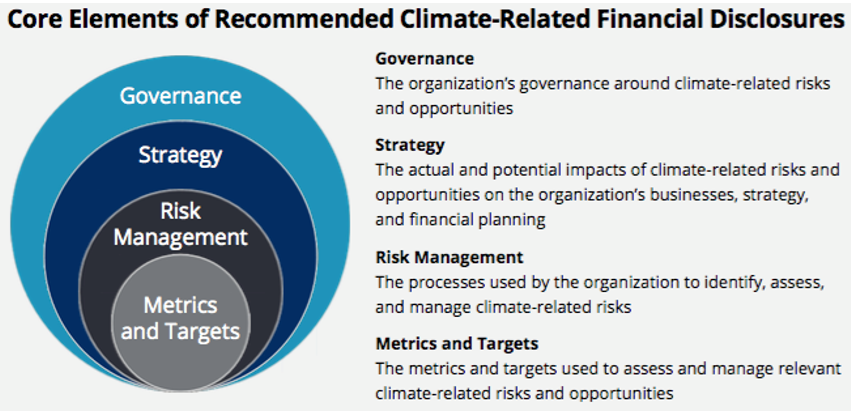Climate change affects all economic sectors and businesses, yet understanding and reporting on its implications is still a challenge, particularly from a financial standpoint. Indeed, 72% of medium and large companies worldwide are not yet reporting on the financial impact of climate change on their business.
To obviate to this, in December 2015, the Financial Stability Board established the industry-led Task-Force on Climate-Related Financial Disclosure (TCFD), to provide a set of practical and consistent recommendations to enable businesses to assess, disclose and manage their climate-related financial risks and allow investors to price climate risks into their investment decisions.
The final recommendations were published in June 2017. Today, over 500 organisations have committed to reporting on their financial exposure to climate change through the TCFD. The recommendations are currently voluntary, although there is a strong feeling that they will become mandatory soon.
In September 2018, we attended the first Business Green Leaders Briefing “Navigating the TCFD Maze”, to share knowledge and best practices with experts in the field and companies that are making use of the recommendations.
Here we outline our 3 key recommendations for any business looking to integrate the TCFD recommendations into their reporting procedures.
- Use Scenario Analysis to improve your strategic resilience
First, you should fully assess the risks and opportunities of climate change for your business. Through workshops and interviews, you can gather the views of relevant stakeholders within (and outside, if necessary) your company and explore how operations are affected by climate change. One of the outcomes will be a climate change risks register, through which you can assess the resilience of your current approach and strategy.
To understand how risks and opportunities may evolve in the future, thus improving your resilience, the TCFD suggests using Scenario Analysis. This draws on financial and economic variables such as the turnover by region, patterns of technological change, economic activity and the structure of governance, under different scenarios of warming, the most common being a 2-degree scenario.
- Mitigate and Adapt
Once you’ve assessed your current and future climate change vulnerability, you are ready to implement strategic responses to ensure business resilience in the short, medium and long-term. Your response should include both climate change mitigation AND adaptation options.
Mitigation is about all actions that reduce the environmental impact of your business, particularly carbon emissions. Adaptation concerns the anticipation of the adverse impact of climate change on business operations and the prevention or minimisation of potential damage.
For example, through Scenario Analysis, real estate company Landsec found that rising average annual temperatures, more erratic temperature changes, storms and flooding would have resulted in higher cooling, heating and maintenance costs. Among the mitigation and adaptation measures they adopted were: divesting from assets at risk of flooding or overheating, investing in systems to reduce the impact of cooling costs, designing buildings to maximise cooling and to reduce heating capacity.
- Disclose, monitor and improve
Use the TCFD framework and recommendations to start reporting what you can as early as possible – this is likely to start with more narrative reporting – and develop a roadmap towards full integration over a number of years.
The recommendations are structured around four thematic areas of disclosure:

The TCFD recommendations and disclosure guidance
- Governance: your governance around climate change risks and opportunities.
In their Sustainability Report, Allianz Group discloses the responsibilities, tasks and achievements of its internal committees that oversee climate-related initiatives. Among these committees are: the Group ESG Board, which oversees the Group Climate Change Strategy and the Group Corporate Responsibilities Department, which integrate climate aspects into core investment and insurance activities.
- Strategy: your strategy to deal with the identified climate change risks and opportunities
Danone assesses the risks that natural disasters pose to its supply chain, particularly on natural water cycles, soil, biodiversity and ecosystems. The business chooses sites with the least possible exposure to natural disasters and tries and protect those sites which are more likely to be impacted.
- Risk management: the process you use to identify, assess and manage your climate change risks
In its Sustainability Performance Report, Westpac Group describes its integration of climate-related risks and opportunities into its strategy and risk management processes, and reports on its procedures to assess the financial risks of climate change for their customers that are in, or reliant on, emission-intensive sectors.
- Metrics and targets: the KPIs used to assess and manage your climate-related risks and opportunities
The TCFD asks Asset Management firms to disclose GHG emissions associated with their investments. Both asset manager Amundi and asset owner AP2 disclose metrics related to emissions associated with their portfolio.
Overall, the TCFD recommendations provide a strategic, practical and consistent framework for companies to develop effective climate-related financial disclosure. Including climate-related issues into mainstream annual reporting will allow your business to monitor and improve its climate-related performance, enabling practices and techniques to evolve rapidly.
If you are interested in exploring your exposure to climate change risks and in implementing the TCFD recommendations, please get in touch.
 >
>Request a call-back
"*" indicates required fields



